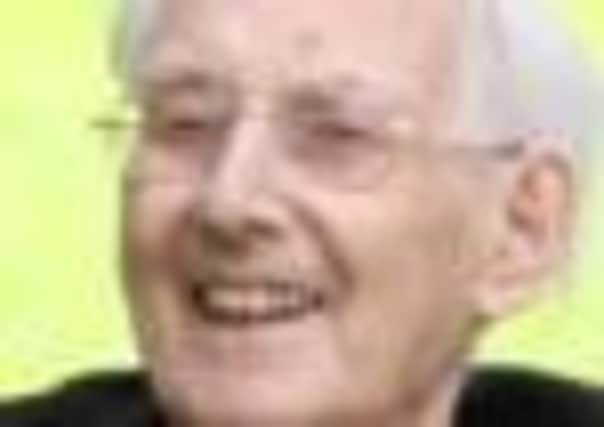Obituary: Rev L David Levison, minister


David was the third son of Sir Leon and Lady Kate Levison. Born in Edinburgh, he was educated at George Watson’s College, Edinburgh University, Westminster College, Cambridge, and New College Edinburgh.
He began his ministry as assistant at St Cuthbert’s Church in Edinburgh where, in 1942, he married Cecilia, an English honours graduate.
Advertisement
Hide AdAdvertisement
Hide AdThereafter he was asked by George Macleod to go to Perth to St Johns, the Kirk of Perth, where he was ordained in 1943. While there, with members of the Youth Fellowship, he turned the old Perth prison into a remarkable youth centre with a wide range of facilities and a daily act of worship in one of the refurbished cells.
He was now a member of the Iona Community and began taking groups of young people to Iona.
He moved to his first parish of Gorebridge, Midlothian in 1946 – a mining parish with two working mines.
The miners equipped him with the necessary helmet, elbow and knee-pads, boots and overalls so he could visit them along the damp, narrow tunnels of the mines.
A popular innovation was the “Penny Pictures” where he introduced Gorebridge youngsters to the delights of Charlie Chaplin and the Keystone Cops. He also wrote a regular column for the local press.
In 1954 he was invited to join the secretariat of the Foreign Mission Committee, at 121 George Street, at a time when the Church of Scotland had 320 missionaries serving in 18 mission fields. In 1959, wishing to return to parish work, the National Church Extension Committee appointed him to the central parish in the new town of Glenrothes. He called the new church St Columba’s. Alberto Morocco, head of the art college in Dundee, produced a remarkable mural 50ft x 8ft as a background to worship.
Among several innovative things were daily short evening acts of worship and the house church: at one time 30 of his elders had a monthly district meeting of members in their homes following programmes prepared at the monthly Kirk Session meetings.
After 11 years in Glenrothes, he became convener of the ethical and moral welfare committee of the General Assembly and decided to seek a parish near Edinburgh. In 1971 he was inducted to the rural parish of Pencaitland, in East Lothian. He served there until retiring in 1982.
Advertisement
Hide AdAdvertisement
Hide AdDuring his time leading the ethical and moral welfare committee he wrote much about changing attitudes to marriage, including Today’s Questions on Marriage and Why Marriage? published by St Andrews Press. As a result of this he and Cecilia were asked to represent the British Council of Churches at a world conference in Tanzania – Familia 74 – where he spoke on world population, and before going on to visit the South African Church Council he was asked to make a presentation to Julius Nyrere, the first president of Tanzania.
He also conducted a service in Dar-es-Salaam, the capital, with, in the front pews, president Milton Obote and his family, who had been expelled from Uganda by Idi Amin.
Immediately on retirement in 1982 they went to London to live with their eldest son to help to bring up four grandchildren whose mother had died suddenly. He was in London for three years, joined the Presbytery of England, was involved and took services in several United Reformed congregations. Returning to Scotland after sharing in the service at his son’s second marriage, he and his wife settled in Haddington.
In 1984 he and Cecilia were asked to join a team of 20 led by Dr John Fleming, an former missionary from China, now lecturing in St Andrews, but still fluent in Chinese. The team went to China where they successfully contacted the young church in the aftermath of the counter revolution. Back in Haddington David was invited to act as associate minister in St Mary’s Collegiate church, where he produced an 18-page colour brochure of the church’s history, which ran to more than 5,000 copies.
He was then appointed chairman of the East Lothian Council of Social Service, out of which sprang the Haddington Day Centre and the East Lothian branch of Cruse Bereavement Care, which he chaired for eight years. Still ready to occupy pulpits, he looked after St Magnus Cathedral in Orkney for two consecutive Octobers to give the incumbent his holidays, and also the Scots Kirk in Paris for the same reason.
Throughout his years in a parish he taught a weekly school class which he considered an important part of his ministry, bringing the gospel to many young people who had no other church connection.
He was a keen supporter of the Ecumenical Movement and strove to bring different branches of the church closer together. He was moderator of three different presbyteries during his ministry.
His was a varied and exciting ministry, owing much to his membership of the Iona Community, and especially to the unstinting support of his wife, who served as the president of the women’s guilds in his congregations, a national vice president of the guild and with whom he celebrated 70 years of happy marriage a fortnight before his death.
Advertisement
Hide AdAdvertisement
Hide AdThere are three children (two doctors, one minister), 13 grandchildren and 23 great-grandchildren. His hobbies were gardening, oil painting, writing poetry and sailing. He enjoyed adventurous holidays with his family in the early years of caravanning in north-west Highlands, always with a canoe on the car roof. He had a warm sense of humour and took a lively interest in sport and politics.
He wrote to MPs and prime ministers even into his 95th year, making suggestions and taking an active part in the democratic process. Altogether he lived a rich and fulfilled life both in the centre of his family and in the service of the home and the world church for which we give thanks.
CHRIS LEVISON